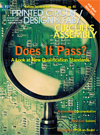September 2010

FEATURES
Documentation
Automating the Documentation Process
“Documentation is much bigger than just design, fab and assembly,” experts say. A look at best-in-class processes that reduce the amount of time spent on drawings and notes by creating a “living” document.
by Mike Buetow
DfM
Best Practices for Double-Sided Mixed-Technology Boards
Plated through-hole assembly remains in use for some heavy power connectors, transformers and other devices where strong mechanical bonds are required. Reason: Heavy parts are prone to falling off during soldering.
by George Henning
COVER STORY
A Critique of IPC-A-610E
The industry standard for visual acceptance criteria for post-assembly soldering and mechanical assembly requirements has been revised. A master trainer assesses the revised guidelines, looking at the many changes to package-on-package and leadless device packages, flex circuits, board-in-board connections and newer style SMT terminations.
by Bob Wettermann
Solder Materials
Present and Future Solder Technologies
Next-gen product relies on advanced powder technologies, better flux formulations, and dual-function materials such as epoxy fluxes. How powders, activator chemistries and fluxes are evolving for production use.
by Neil Poole, Ph.D., and Brian Toleno, Ph.D.
SMT Cleaning
Post-Reflow Residue Results Following pH-Neutral Cleaner Application
A study of 40 leaded and Pb-free solders compares alkaline to pH-neutral cleaning agents.
by Harald Wack, Ph.D., Joachim Becht, Ph.D., Michael McCutchen and Umut Tosun
FIRST PERSON
- Caveat Lector
Overreach?
Mike Buetow
MONEY MATTERS
-
Sherman’s Market
Foxconn’s suicide cluster, in context.
Randall Sherman -
Global Sourcing
Low cost: the death of innovation.
Richard Platt -
ROI
Standard mistakes.
Peter Bigelow
TECH TALK
-
On the Forefront
LEDs’ bright future.
E. Jan Vardaman -
Selective Soldering
A primer on nozzle types.
Alan Cable -
Tech Tips
Ball attachment with preforms.
ACI Technologies Inc. -
Test and Inspection
Eight steps to great ICT coverage.
Jun Balangue -
SMT Troubleshooting
Reflow-related bridging.
Paul Lotosky -
Defects Database
Finer powders, more solder balling?
Dr. Davide Di Maio -
Process Doctor
Cleaning’s building blocks.
Dr. Harald Wack -
Solar Technologies
The solar show circuit.
Andy Ure -
Materials World
Soured by graping?
Jie Bai -
Technical Abstracts
In Case You Missed It.
Mike Buetow




